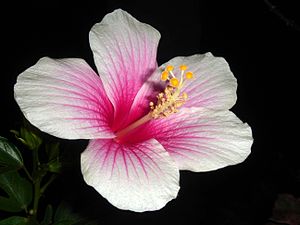Note: This is a project under development. The articles on this wiki are just being initiated and broadly incomplete. You can Help creating new pages.
Hibiscus rosa sinensis - Rudrapushpa
Rudrapushpa is a sanskrit name of Hibiscus rosa. This floweer is originateed in China. It is also used as a Decorative flower. In Chian and Philiphines a fresh Hibiscus rosa is used for coocking.
Contents
- 1 Uses
- 2 Parts Used
- 3 Chemical Composition
- 4 Common names
- 5 Properties
- 6 Habit
- 7 Identification
- 8 List of Ayurvedic medicine in which the herb is used
- 9 Where to get the saplings
- 10 Mode of Propagation
- 11 How to plant/cultivate
- 12 Commonly seen growing in areas
- 13 Photo Gallery
- 14 References
- 15 External Links
Uses
Leucorrhea, Haemorrhoids, Fever, Burning sensation, Skin eruptions, Blotches, Pimples, Diarrhea, Diabetes
Parts Used
Chemical Composition
Carbohydrates, Lipids, Proteins, Nucleotides and nucleic acids[1]
Common names
| Language | Common name |
|---|---|
| Kannada | Kaama gaggare, Kaama kasturi |
| Hindi | Babui, Babuitulsi |
| Malayalam | Pach-cha-pushpam, Pachcha |
| Tamil | Cankanirakkarantai, Capcavitai |
| Telugu | Bhoo tulasi, Bhu-tulasi |
| Marathi | NA |
| Gujarathi | NA |
| Punjabi | NA |
| Kashmiri | NA |
| Sanskrit | Ajagandhika, ajaka |
| English | NA |
Properties
Reference: Dravya - Substance, Rasa - Taste, Guna - Qualities, Veerya - Potency, Vipaka - Post-digesion effect, Karma - Pharmacological activity, Prabhava - Therepeutics.
Dravya
Rasa
Guna
Veerya
Vipaka
Karma
Prabhava
Habit
Identification
Leaf
| Kind | Shape | Feature |
|---|---|---|
| Simple | Dorsiventral | Both the glandular and stellate types of trichomes are present. Stomata are of ranunculaceous or rubiaceous typa, present on the lower surface |
Flower
| Type | Size | Color and composition | Stamen | More information |
|---|---|---|---|---|
| Unisexual | 2-4cm long | Yellow | 5-20 | Flower powder shows spheroidal, pantoporate, pore-circular pollen grains; stellate trichomes single,elongated, conical or twisted and convoluted |
Fruit
| Type | Size | Mass | Appearance | Seeds | More information |
|---|---|---|---|---|---|
| simple | 4-8 cm | clearly grooved lengthwise, Lowest hooked hairs aligned towards crown | With hooked hairs | many | {{{6}}} |
Other features
List of Ayurvedic medicine in which the herb is used
Where to get the saplings
Mode of Propagation
How to plant/cultivate
A common way to propagate tropical hibiscus is through stem cuttings. The cuttings should be about 8 inches long, with the stem cut at an angle. The cut should be made directly through a leaf node. All but the top two leaves must be removed, as well as any buds or flowers. The planting medium commonly used is coarse builder's sand or perlite. [4]
Commonly seen growing in areas
Tropical area, Subtropical area, Temperate area.
Photo Gallery
References
External Links
- Ayurvedic Herbs known to be helpful to treat Leucorrhea
- Ayurvedic Herbs known to be helpful to treat Haemorrhoids
- Ayurvedic Herbs known to be helpful to treat Fever
- Ayurvedic Herbs known to be helpful to treat Burning sensation
- Ayurvedic Herbs known to be helpful to treat Skin eruptions
- Ayurvedic Herbs known to be helpful to treat Blotches
- Ayurvedic Herbs known to be helpful to treat Pimples
- Ayurvedic Herbs known to be helpful to treat Diarrhea
- Ayurvedic Herbs known to be helpful to treat Diabetes
- Herbs with Leaves used in medicine
- Herbs with Roots used in medicine
- Herbs with Flowers used in medicine
- Herbs with Seeds used in medicine
- Herbs with common name in Kannada
- Herbs with common name in Hindi
- Herbs with common name in Malayalam
- Herbs with common name in Tamil
- Herbs with common name in Telugu
- Herbs with common name in Sanskrit
- Habit - Herb
- Index of Plants which can be propagated by Seeds
- Index of Plants which can be propagated by Cuttings
- Herbs that are commonly seen in the region of Tropical area
- Herbs that are commonly seen in the region of Subtropical area
- Herbs that are commonly seen in the region of Temperate area
- Herbs
- Malvaceae



